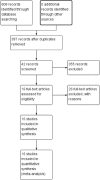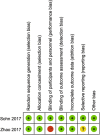Comparison between minimally invasive plate osteosynthesis and open reduction-internal fixation for proximal humeral fractures: a meta-analysis based on 1050 individuals
- PMID: 31739803
- PMCID: PMC6862799
- DOI: 10.1186/s12891-019-2936-y
Comparison between minimally invasive plate osteosynthesis and open reduction-internal fixation for proximal humeral fractures: a meta-analysis based on 1050 individuals
Abstract
Background: This meta-analysis aimed to compare the clinical outcomes and complications of minimally invasive plate osteosynthesis (MIPO) and open reduction-internal fixation (ORIF) in patients with proximal humeral fractures.
Methods: We searched PubMed, EMBASE, Ovid, and the Cochrane Library to identify all relevant studies from inception to April 2019. Cochrane Collaboration's Review Manage 5.3 was used for meta-analysis.
Results: Sixteen studies involving 1050 patients (464 patients in the MIPO group and 586 patients in the ORIF group) were finally included. According to the meta-analysis, MIPO was superior to ORIF in operation time, blood loss, postoperative pain, fracture union time, and constant score. However, MIPO was associated with more exposure to radiation and axillary nerve injury. No significant differences were found in length of hospital stays and complication except for axillary nerve injury.
Conclusion: The present evidence indicates that compared to ORIF, MIPO had advantages in functional outcomes, operation time, blood loss, postoperative pain, and fracture union time for the treatment of PHFs. However, the MIPO technique had a higher rate of axillary nerve injury and longer radiation time compared to ORIF.
Keywords: Meta-analysis; Minimally invasive plate osteosynthesis (MIPO); Open reduction–internal fixation (ORIF); Proximal humeral fractures.
Conflict of interest statement
The authors declare that they have no competing interests.
Figures










References
-
- Calvo E, Morcillo D, Foruria AM, Redondo-Santamaría E, Osorio-Picorne F, Caeiro JR, et al. Nondisplaced proximal humeral fractures: high incidence among outpatient-treated osteoporotic fractures and severe impact on upper extremity function and patient subjective health perception. J Shoulder Elbow Surg. 2011;20:795–801. doi: 10.1016/j.jse.2010.09.008. - DOI - PubMed
Publication types
MeSH terms
Grants and funding
LinkOut - more resources
Full Text Sources
Medical
Miscellaneous

